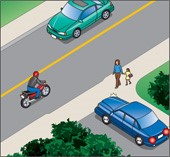Residential section
This driving task is done on straight sections of residential or rural road. Remember these points:
Traffic check
On a residential road, watch out for entrances to schools, pedestrian crossings, driveways, sidewalks and any other locations where there might be traffic hazards. On rural roads, watch out for entrances to residences, farms, businesses and industrial sites. At all these locations, look left and right to check for vehicles or pedestrians about to enter the road.
Mirror check
While driving along, check your mirrors every five to 10 seconds. Check your mirrors more often in heavy traffic or where vehicles are moving at different speeds.
Lane
Generally, drive in the left tire track. If there are no lane markings, stay on the travelled part of the road. On a wide residential street, stay toward the centre of the road away from parked vehicles or pedestrians. Where you cannot see far ahead on the road because of a curve or a hill, drive in a tire track that will keep you from colliding with an oncoming vehicle that is over the centre line. Look ahead to where you will be in the next 12 to 15 seconds for dangerous situations or obstacles that you can avoid by changing lanes.
Speed
Avoid exceeding the speed limit or driving unreasonably slowly. Whenever possible, drive at a steady speed. Look ahead to where you will be in the next 12 to 15 seconds for dangerous situations or obstacles that you can avoid by changing your speed.
Space
Keep at least a two- to three-second distance behind the vehicle in front of you. Increase the distance if another vehicle follows too closely behind you. In slow traffic, avoid driving behind large vehicles that block your view of traffic ahead of you. When you stop behind another vehicle, stay behind at least one motorcycle length.
